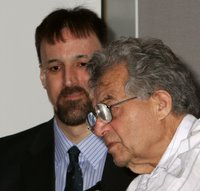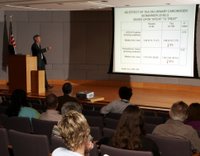Summary of GEMS 2006 Spring Meeting
Gloria Jahnke, Secretary
and photos by Steve McCaw, Image Associates
The GEMS 2006 Spring Meeting was held Monday April 24, 2006 at the North Carolina  Biotechnology Center in Durham NC. Six invited speakers addressed the meeting topic “Antimutagenesis and Anticarcinogenesis.” There were 72 attendees. President Dr. Les Recio welcomed the attendees and President-Elect Dr. Greg Stuart introduced the speakers.
Biotechnology Center in Durham NC. Six invited speakers addressed the meeting topic “Antimutagenesis and Anticarcinogenesis.” There were 72 attendees. President Dr. Les Recio welcomed the attendees and President-Elect Dr. Greg Stuart introduced the speakers.
Dr. Rudolph Salganik from the School of Public Health and the Department of Nutrition at the University of North Carolina, Chapel Hill, gave the opening presentation “Apoptosis Against Mutagenesis and Carcinogenesis.” Dr. Salganik suggested that temporarily depleting dietary antioxidants increases the concentration of reactive oxygen species (ROS) selectively in cancer cells, resulting in the death of tumor cells. This approach has been verified using transgenic mice, and additional studies are currently underway. Cachexia, a tragic complication of cancer, results in wasting of muscle tissues and body mass with no effective means of treatment. Dr. Salganik presented preliminary data supporting the hypothesis that the accumulation of ROS in cancer cells might decrease secretion of cachectic factors and reduce deadly manifestations of cachexia.
University of North Carolina, Chapel Hill, gave the opening presentation “Apoptosis Against Mutagenesis and Carcinogenesis.” Dr. Salganik suggested that temporarily depleting dietary antioxidants increases the concentration of reactive oxygen species (ROS) selectively in cancer cells, resulting in the death of tumor cells. This approach has been verified using transgenic mice, and additional studies are currently underway. Cachexia, a tragic complication of cancer, results in wasting of muscle tissues and body mass with no effective means of treatment. Dr. Salganik presented preliminary data supporting the hypothesis that the accumulation of ROS in cancer cells might decrease secretion of cachectic factors and reduce deadly manifestations of cachexia.
Next, Dr. Karen Katula from the Department of Biology at the University of North Carolina, Greensboro gave a presentation entitled “Folate and Carcinogenesis: A Complex Relationship Based on Multiple Mechanisms.” After introducing the topic of folate deficiency and adverse health outcomes including cancer, Dr. Katula described her studies exploring the mechanistic link between folate deficiency and changes in gene expression. Microarray analyses using normal human fibroblast and lymphoblast cell lines identified a small set of genes selected for further study. Follow-up analyses indicated that a subset of genes linked to the Ras and Wnt pathways are sensitive to folate deficiency. These results suggested an alternative mechanism for how folate deficiency leads to changes in gene expression and altered cell function.
Following Dr. Zeiger’s presentation, an exceptional buffet-style lunch featuring sandwich wraps, pasta salad, fruit salad, and desserts was served by Chef Mario Catering. During lunchtime and throughout the meeting, “career mentors” were available to advise students and postdoctoral fellows regarding employment opportunities. The following mentors kindly volunteered their expertise: from industry, Drs. Jeff Ambroso (GlaxoSmithKline), Les Recio (Integrated Laboratory Systems), and Errol Zeiger (Errol Zeiger Consulting); from academia, Drs. Mark Miller (Wake Forest University), Mary Smith (North Carolina A&T State University), and Jayne Boyer (University of North Carolina); and, from government, Drs. Janice Allen (NIEHS) and Jeff Ross (USEPA).
Dr. Alan Townsend from the Department of Biochemistry at the Wake Forest University School of Medicine led the afternoon session with a presentation entitled “Protection Against Carcinogen Genotoxicity by Glutathione Transferases Co-Expressed with Cytochrome P-450.” Dr. Townsend described his studies that examined the metabolism and detoxification of selected carcinogens, including the polycyclic aromatic hydrocarbon benzo[a]pyrene and its enantiomeric dihydrodiol metabolites. These investigations employ the use of transgenic cell lines (including V79 hamster cells) that express specific human cytochrome P450 (including hCYP1A1) and glutathione S-transferase isozymes (including hGSTP1), to study the dynamics of competition between activation versus detoxification of carcinogens and their metabolites. Endpoints examined included cytotoxicity, macromolecular damage (DNA adducts) and mutagenicity, and their reduction by co-expression with hGSTP1.
Next, Dr. Daniel Shaughnessy from the Laboratory of Molecular Carcinogenesis at the National Institute of Environmental Health Sciences (RTP, NC) presented his work on “Dietary Antimutagens: Studies in Bacteria and Humans.” Dr. Shaughnessy described the results from two chemoprevention studies. In the first, human participants in a controlled study were fed a defined diet containing highly fried beef (containing elevated levels of mutagenic heterocyclic amines), as well as the protective substances cruciferous vegetables, yogurt, or daily chlorophyllin tablets. Colorectal biopsies were obtained for determination of DNA damage, and mutagenicity studies were performed using urine and fecal samples. The results showed that the dietary interventions with the antimutagens reduced by the level of DNA damage in the target tissue, the colon, by two-fold. Dr. Shaughnessy also investigated the effects of vanillin and cinnamaldehyde on mutational spectra in Salmonella, DNA repair-deficient strains of E. coli, and antimutagenesis at the HPRT locus in human cells. The results show that these antimutagens reduce spontaneous mutations by inducing recombinational DNA repair.
Dr. Thomas Kensler, Director of the Division of Toxicological Sciences, Department of Environmental Health  Sciences at John Hopkins University concluded the presentations with stimulating presentation entitled “Role of Keap1-Nrf2 Signaling in Cancer Chemoprevention.” Dr. Kensler described results from his laboratory that investigated the molecular mechanisms of action of chemopreventive agents such as dithiolethiones and oltipraz. These studies included the use of Nrf2-deficient mice to assess the impact of this transcription factor on both basal expression and induction of glutathione S-transferases and NAD(P)H:quinone reductase by oltipraz. Dr. Kensler also provided an overview of his pivotal clinical trials in Qidong, P.R. China. Dr. Kensler, and colleagues, demonstrated that the consistent exposure of individuals in this region to dietary aflatoxins indicated a prime role for aflatoxin in the etiology of liver cancer. Consequently, clinical chemoprevention trials of the dithiolethione oltipraz, and other agents, are currently underway in Qidong to determine if intervention with oltipraz can reduce the incidence of liver cancer.
Sciences at John Hopkins University concluded the presentations with stimulating presentation entitled “Role of Keap1-Nrf2 Signaling in Cancer Chemoprevention.” Dr. Kensler described results from his laboratory that investigated the molecular mechanisms of action of chemopreventive agents such as dithiolethiones and oltipraz. These studies included the use of Nrf2-deficient mice to assess the impact of this transcription factor on both basal expression and induction of glutathione S-transferases and NAD(P)H:quinone reductase by oltipraz. Dr. Kensler also provided an overview of his pivotal clinical trials in Qidong, P.R. China. Dr. Kensler, and colleagues, demonstrated that the consistent exposure of individuals in this region to dietary aflatoxins indicated a prime role for aflatoxin in the etiology of liver cancer. Consequently, clinical chemoprevention trials of the dithiolethione oltipraz, and other agents, are currently underway in Qidong to determine if intervention with oltipraz can reduce the incidence of liver cancer.
The meeting was followed by a reception featuring assorted cheeses, roast pork, grilled vegetables, Mexican cheesecake, crab and artichoke dip, and a punch beverage. The GEMS Board of Directors wishes to sincerely thank those who contributed to the success of this meeting, and welcomes ideas and suggestions for future GEMS meetings (please email your suggestions to Greg Stuart at stuart@niehs.nih.gov). The Board would also like to extend a special ‘thank you’ to Susan Ross and the CIIT Centers for Health Research for their contribution of name badges and signs for the meeting, Integrated Laboratory Systems for providing the programs, and financial support generously provided by the North Carolina Biotechnology Center.
meeting, and welcomes ideas and suggestions for future GEMS meetings (please email your suggestions to Greg Stuart at stuart@niehs.nih.gov). The Board would also like to extend a special ‘thank you’ to Susan Ross and the CIIT Centers for Health Research for their contribution of name badges and signs for the meeting, Integrated Laboratory Systems for providing the programs, and financial support generously provided by the North Carolina Biotechnology Center.




<< Home